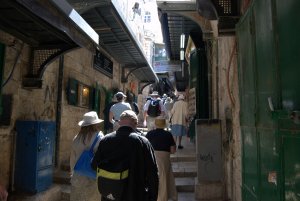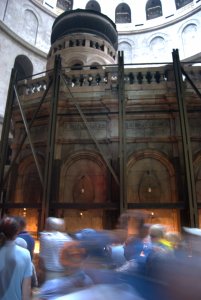After lunch and the celebration of the Eucharist we partially retraced our steps to begin the Via Dolorosa, the Way of the Cross. Essentially this is a devotional exercise rather than an exact tracing of the exact events of 2,000 years ago, if only because so many of the sites are “traditional”. Recent archaeological explorations in certain areas of the Old City suggest that at the time of Jesus the street level was perhaps as much as three metres below today’s level so Jesus almost certainly did not ‘tread on these very stones’. But we have to be careful! The street plan would have been much the same, and in a place which has recycled materials for centuries our scepticism has to be tempered with a certain amount of humility. So, as we trace the traditional route that the condemned – including Jesus – took through the streets to the execution ground and we listen to the relevant extracts from the Gospel accounts we can be caught up in, not re-enactment exactly, but prayerful contemplation of the deeper meaning of the event.
We began our journey at the Al Omariya School where First Station is situated, and where we read from Matthew’s Gospel of Pilate handing over Jesus to be crucified, to pacify the baying mob. Our extract from the Gospel stops before the account of the soldiers mocking him by making a crown of thorns, putting a purple robe on him and hailing him as King of the Jews. I have always thought this to be a gratuitous extra torment by the soldiers, but our guide suggested a different view, which has been suggested by research. Apparently the Roman troops had a gambling game which could be played two ways. Either the winner would be elected ‘king’ for the day and would not have to carry out any of the fatigues, or he would be elected ‘king’ but be responsible for all the menial tasks and would be the butt of the squad. The discovery of such a ‘board’ in a paving slab has led to the suggestion that the squad to whom Jesus was delivered played the game so that Jesus ‘lost’ and was therefore mocked. An interesting idea, which sheds a different light on the event.
As we moved between the Stations in procession we sang, and it was bizarre to see that
nobody took the slightest bit of notice! Of course in that area what we were doing was commonplace: the Franciscan community makes the walk every Friday carrying a cross, and most days there will be at least two groups making the walk, but even so it was bizarre! One of the unexpected discoveries was how much of the route is uphill. At times it was quite difficult to walk and continue singing, which gave some insight as to how exhausting it must have been to carry a heavy cross after a night of suffering and being beaten.
Just as the Stations are “traditional” so some of the events that they commemorate do not appear in Scripture – Veronica for example – but Luke’s Gospel tells of his encounter with the women of Jerusalem, weeping and wailing. And here again was a new thought which I had not considered before. It has been suggested that those women were professional mourners, hired to weep and wail but who had no emotional or personal connection with the person being mourned. Hence Jesus’ words to them: ‘don’t weep for me, weep for yourselves and your children’, are a warning of the troubles to come.
The culmination of the Via Dolorosa is at the Church of the Holy Sepulchre, and this was crowded with several hundred people. It was impossible for us to move to the four Stations within the building, so we completed them close to the 11th Station, the Latin Calvary. After this we had time to look at various chapels and places within the building, but the queue to get into the Sepulchre itself was so long that it would have taken at least an hour to get through.
It may come as a surprise, but my strongest emotion in this Church was that of anger! Yes the place is full of the devout and, indeed, full of prayer, but it is also the site of so much conflict between the competing religious groups who control various parts of the complex. The main groups are the Eastern Orthodox, the Armenia Apostolic and the Roman Catholic Churches. Of the Eastern Orthodox Churches, the major group is the Greek Orthodox. No work, not even a rearrangement, can be carried out in the common areas without the agreement of all the parties. Thus you can see in my photo steel bracing erected in 1947 under the British Mandate because the marble cladding of the Sepulchre is becoming detached and there has so far been no agreement about its repair. Each community is jealous of its rights, and it is not unknown for fights to break out between the various Orthodox communities,and between the Orthodox and the Franciscans over some perceived slights. So yes, I felt anger – and sadness and detachment, and not at all ‘holy’.



